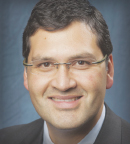In the phase Ib/II CARTITUDE-1 trial reported in The Lancet, Jesus G. Berdeja, MD, and colleagues found that ciltacabtagene autoleucel (cilta-cel), a chimeric antigen receptor (CAR) T-cell therapy with two B-cell maturation antigen (BCMA)-targeting single-domain antibodies, produced a high rate of durable and deep responses in heavily pretreated patients with relapsed or refractory multiple myeloma.

Jesus G. Berdeja, MD
Study Details
One hundred and thirteen patients were enrolled in the U.S. multicenter study; they underwent apheresis between July 2018 and October 2019. Patients had received three or more previous lines of therapy or were double-refractory to a proteasome inhibitor and an immunomodulatory drug and had received a proteasome inhibitor, immunomodulatory drug, and anti-CD38 antibody. Patients received a single cilta-cel infusion at a target dose of 0.75 × 10⁶ CAR-positive viable T cells/kg at 5 to 7 days after the start of lymphodepletion.
Responses
Of the 113 enrolled patients, 16 (14%) did not receive cilta-cel infusion due to disease progression, death, or study withdrawal; no cases of cilta-cel manufacturing failure occurred. A total of 97 patients with a median of six prior treatments received cilta-cel infusion at the recommended phase II dose of 0.75 × 10⁶ CAR-positive viable T cells/kg (range = 0.5 × 10⁶ to 1.0 × 10⁶).
As of the clinical cutoff date (September 2020), median follow-up among the 97 patients was 12.4 months (interquartile range [IQR] = 10.6–15.2 months). Response was achieved in 94 patients (97%, 95% confidence interval [CI] = 91.2%–99.4%), with stringent complete response in 65 (67%), very good partial response in 25 (26%), and partial response in 4 (4%).
Median time to first response was 1 month. Responses deepened over time; median time to best response was 2.6 months, and median time to complete response or better was 1.9 months. Median duration of response was not reached (95% CI = 15.9 months–not estimable).
Median progression-free survival was not reached (95% CI = 16.8 months–not estimable). At 12 months, the progression-free rate was 77% (95% CI = 66.0%–84.3%) and the overall survival rate was 89% (95% CI = 80.2%–93.5%).
KEY POINTS
- Ciltacabtagene autoleucel produced responses in 97% of patients, with stringent compete response in 67%.
- Median time to first response was 1 month, and median duration of response was not reached.
Adverse Events
The most common grade 3 or 4 adverse events were hematologic events, including neutropenia in 95% of patients, anemia in 68%, leukopenia in 61%, thrombocytopenia in 60%, and lymphopenia in 50%. The most common grade 3 or 4 nonhematologic adverse events were neurotoxicities (9%) and hypophosphatemia (7%).
Adverse events led to death in nine patients (9%). Of these, six deaths were considered related to treatment, with causes consisting of sepsis or septic shock in two patients, and cytokine-release syndrome and hemophagocytic lymphohistiocytosis, lung abscess, respiratory failure, and neurotoxicity in one patient each.
Cytokine-release syndrome of any grade occurred in 95% of patients and was grade 3 or 4 in 4%. Median time to onset was 7.0 days, and median duration was 4.0 days. Cytokine-release syndrome resolved in all patients, except a patient with grade 5 cytokine-release syndrome and hemophagocytic lymphohistiocytosis. Neurotoxicity of any grade occurred in 21% of patients, including immune effector cell–associated neurotoxicity syndrome (ICANS) in 17% (2% grade 3–4). Median time to ICANS onset was 8.0 days, and median duration was 4.0 days; ICANS resolved in all patients.
The investigators concluded, “A single cilta-cel infusion at the target dose of 0.75 × 10⁶ CAR-positive viable T cells per kg led to early, deep, and durable responses in heavily pretreated patients with multiple myeloma with a manageable safety profile. The data from this study formed the basis for recent regulatory submissions.”
Sundar Jagannath, MD, of Mount Sinai Medical Center, is the corresponding author for The Lancet article.
Disclosure: The study was funded by Janssen Research & Development and Legend Biotech. For full disclosures of the study authors, visit thelancet.com.

